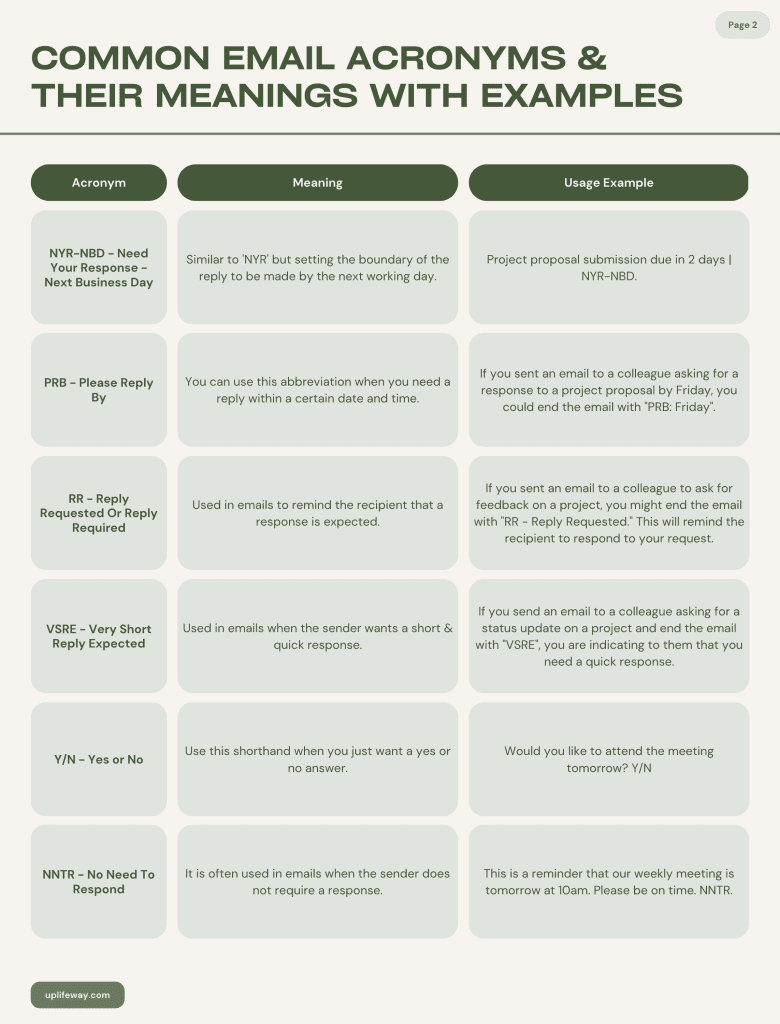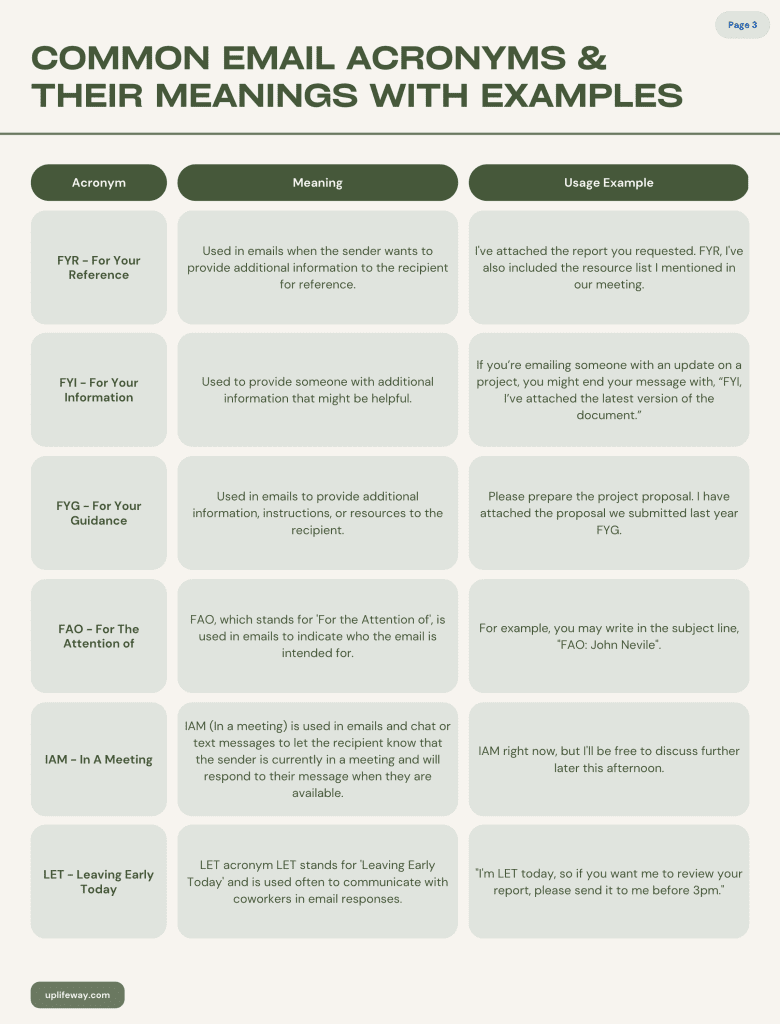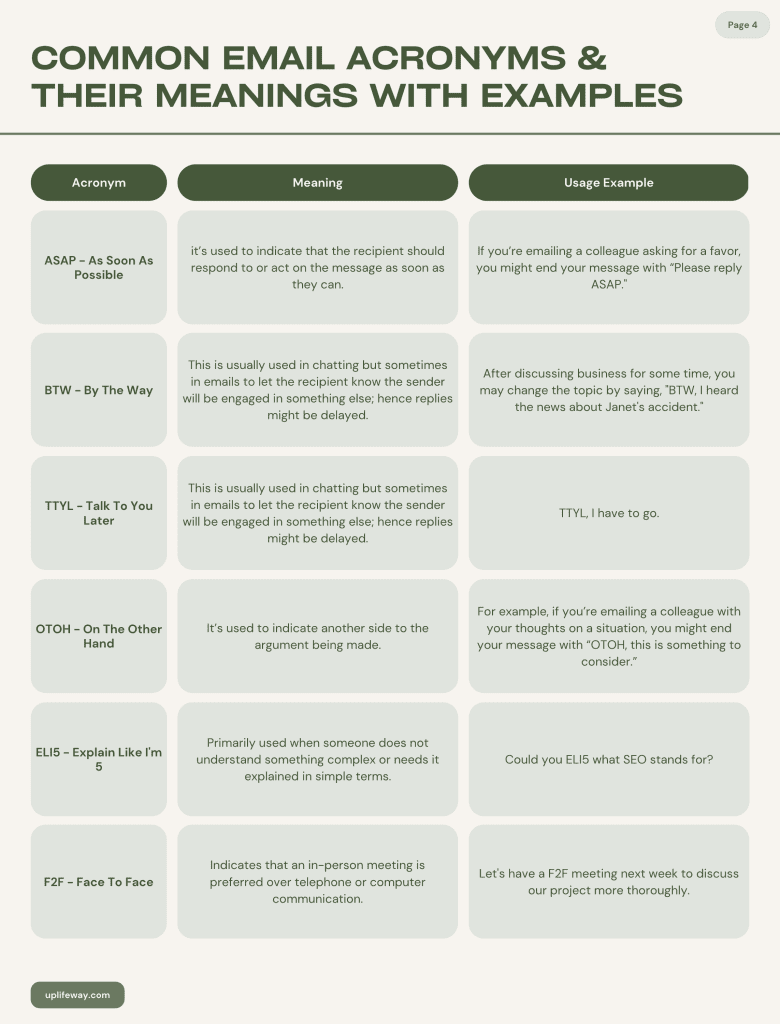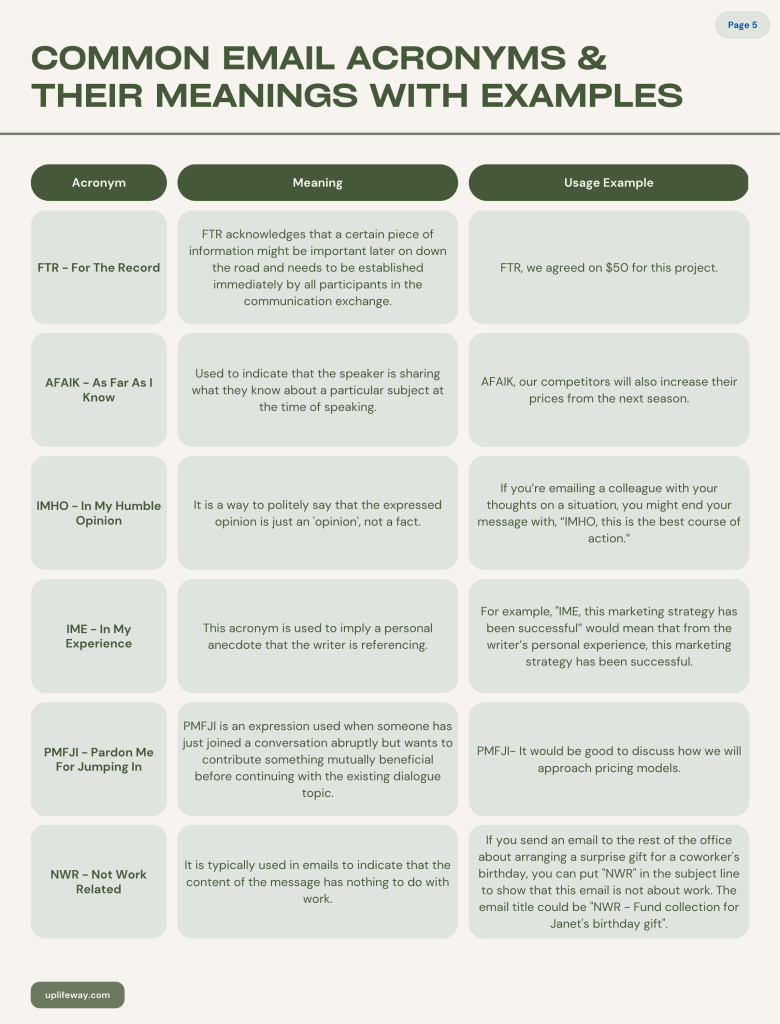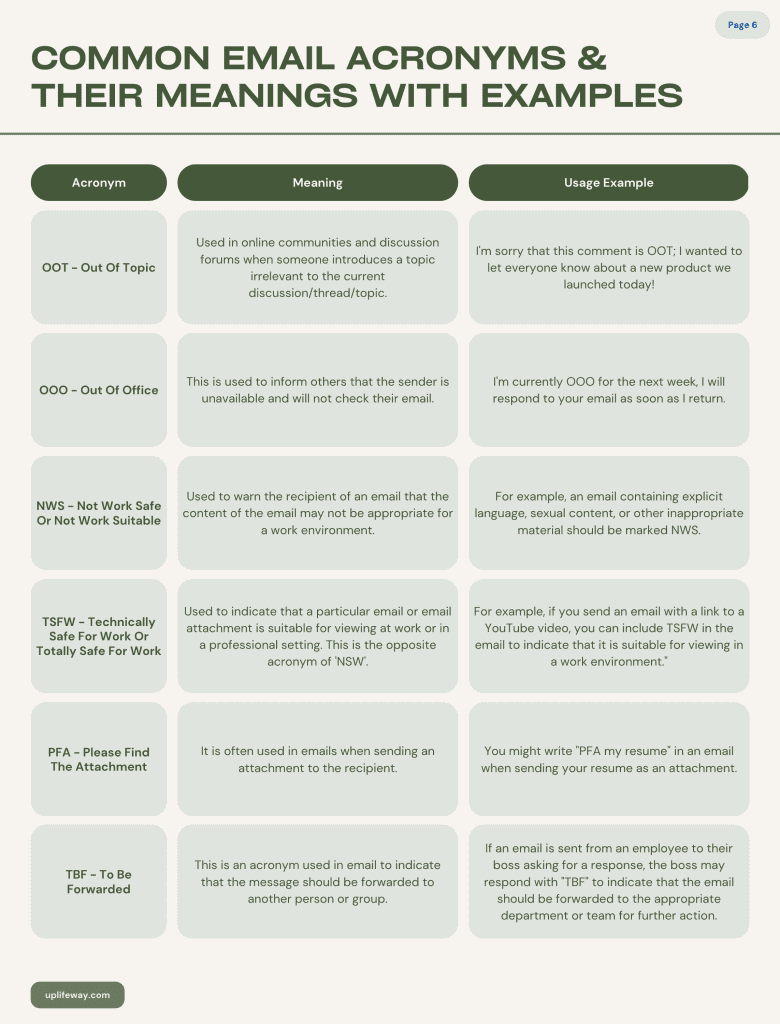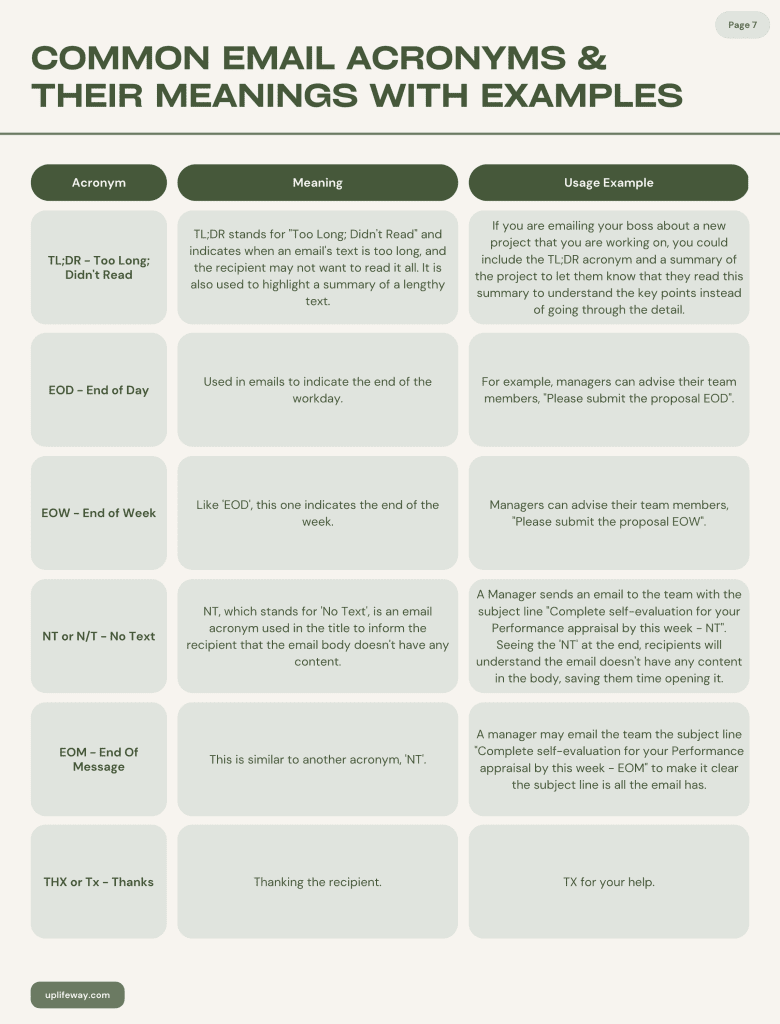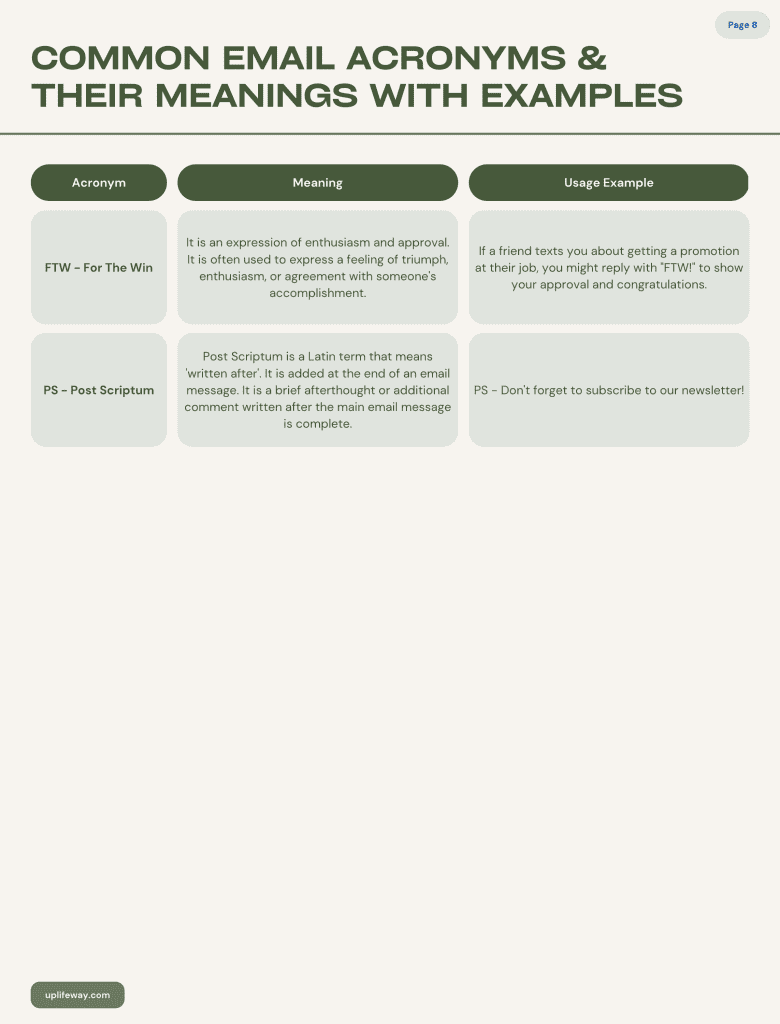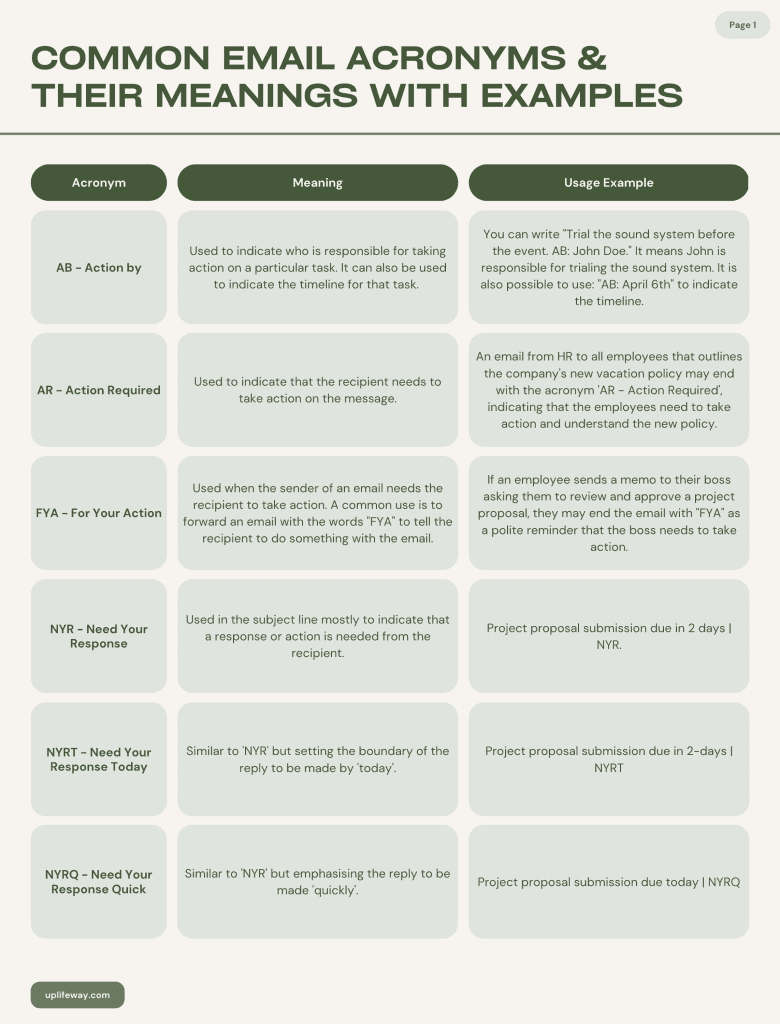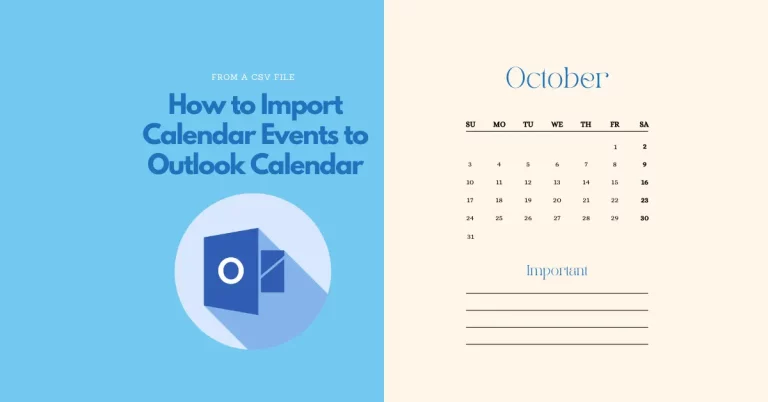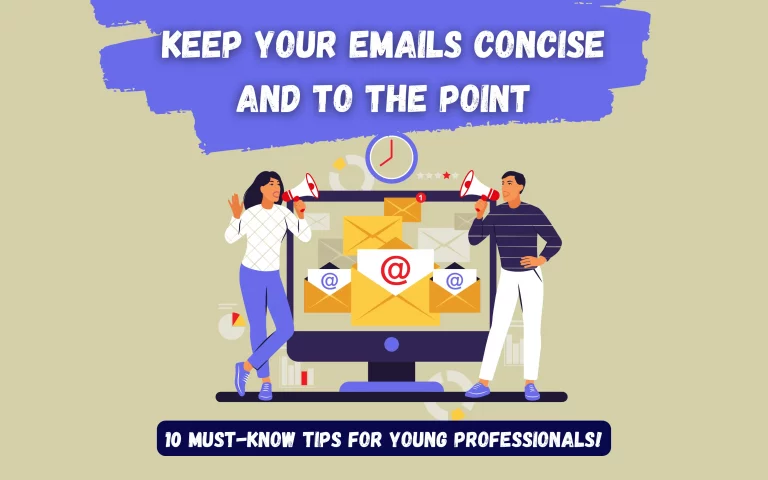44 Professional Email acronyms & abbreviations You Must Know If You Don’t Want to Look Dumb (With pdf Download Format)
Key Takeaway
Email acronyms are shorthand phrases or words used in email messages to quickly communicate an idea or opinion without having to type out the entire phrase. They are a great way to save time and effort when sending a message, but email acronyms can confuse those unfamiliar with them. This guide provides definitions for common business email acronyms and abbreviations with examples of their use in sentences. Finally, there is a print-ready downloadable PDF version also!
Introduction
Let me start with a story. Back then, I was a young professional. My boss sent me an email with an acronym in the subject line “NYRQ”. I didn’t know that it meant “Need Your Response Quick.” So I was relaxed and replied a few days later. What happened after that is a story for another time. But I learned my lesson, went ahead, and learned all the common business email abbreviations. After that day, I never faced such an embarrassing situation again.

We will share the most frequently used professional email abbreviations out there.
44 Common Acronyms for Business Email
Here is a list of corporate email abbreviations and acronyms to make your next emails look more professional.
| 1. AR – Action Required Used to indicate that the recipient needs to take action on the message. For example, an email from HR outlining the company’s new vacation policy may end with the acronym ‘AR – Action Required’, indicating that the employees need to take action and understand the new policy. |
| 2. NYR – Need Your Response Used in the subject line mainly to indicate that a response or action is needed from the recipient. Example: Project proposal submission due in 2 days | NYR. |
| 3. FYA – For Your Action Used when the sender of an email needs the recipient to take action. A common use is to forward an email with the words “FYA” to tell the recipient to do something with the email. If an employee sends a memo to their boss asking them to review and approve a project proposal, they may end the email with “FYA” as a polite reminder that the boss needs to take action. |
| 4. PRB – Please Reply By Use this abbreviation when you need a reply within a certain date and time. If you emailed a colleague asking for a response to a project proposal by Friday, you could end the email with “PRB: Friday”. |
| 5. NYRT – Need Your Response Today Similar to ‘NYR’ but setting the boundary of the reply to be made by ‘today’. Example: Project proposal submission due in 2 days | NYRT. |
| 6. NYRQ – Need Your Response Quick Similar to ‘NYR’ but emphasizing the reply to be made quickly. Example: Project proposal submission due today | NYRQ |
| 7. NYR-NBD – Need Your Response – Next Business Day Similar to ‘NYR’ but setting the boundary of the reply to be made by the next working day. Example: Project proposal submission due in 2 days | NYR-NBD. |
| 8. RR – Reply Requested or Reply Required Used in emails to remind the recipient that a response is expected. For example, if you emailed a colleague to ask for feedback on a project, you might end the email with “RR – Reply Requested.” This will remind the recipient to respond to your request. |
| 9. VSRE – Very Short Reply Expected Used in emails when the sender wants a short & quick response. For example, if you email a colleague asking for a status update on a project and end the email with “VSRE”, you are indicating to them that you need a quick response. |
| 10. Y/N – Yes or No Use this shorthand when you want a yes or no answer. Example: Would you like to attend the meeting tomorrow? Y/N. |
| 11. ASAP – As Soon As Possible it’s used to indicate that the recipient should respond to or act on the message as soon as possible. If you’re emailing a colleague asking for a favor, you might end your message with “Please reply ASAP.” |
| 12. NNTR – No Need To Respond It is often used in emails when the sender does not require a response. This is a reminder that our weekly meeting is tomorrow at 10 am. Please be on time. NNTR. |
| 13. FYR – For Your Reference Used in emails when the sender wants to provide additional information to the recipient for reference. Example: I’ve attached the report you requested. FYR, I’ve also included the resource list I mentioned in our meeting. |
| 14. FYI – For Your Information Used to provide someone with additional information that might be helpful. If you’re emailing someone with an update on a project, you might end your message with, “FYI, I’ve attached the latest version of the document.” |
| 15. FYG – For Your Guidance Used in emails to provide additional information, instructions, or resources to the recipient. Example: Please prepare the project proposal. I have attached the proposal we submitted last year FYG. |
| 16. FAO – For The Attention of FAO, which stands for ‘For the Attention of’, is used in emails to indicate who the email is intended for. For example, you may write in the subject line, “FAO: John Nevile”. |
| 17. IAM – In A Meeting IAM (In a meeting) is used in emails and chat or text messages to let the recipient know that the sender is currently in a meeting and will respond to their message when they are available. Example: IAM right now, but I’ll be free to discuss further later this afternoon. |
| 18. LET – Leaving Early Today LET acronym LET stands for ‘Leaving Early Today’ and is used often to communicate with coworkers in email responses. Example: I’m LET today, so if you want me to review your report, please send it to me before 3 pm. |
| 19. AFAIK – As Far As I Know Used to indicate that the speaker is sharing what they know about a particular subject when speaking. Example: AFAIK, our competitors will also increase their prices from the next season. |
| 20. BTW – By The Way This is usually used in chatting but sometimes used in emails as well. It is used to change the topic. For example, after discussing business for some time, you may change the topic by saying, “BTW, I heard the news about Janet’s accident.” |
| 21. TTYL – Talk To You Later This is usually used in chatting but sometimes in emails to let the recipient know the sender will be engaged in something else; hence replies might be delayed. Example: TTYL, I have to go. |
| 22. OTOH – On The Other Hand It’s used to indicate another side to the argument being made. For example, if you’re emailing a colleague with your thoughts on a situation, you might end your message with “OTOH, this is something to consider.” |
| 23. ELI5 – Explain Like I’m 5 Primarily used when someone does not understand something complex or needs it explained in simple terms. Example: Could you ELI5 what SEO stands for? |
| 24. F2F – Face To Face Indicates that an in-person meeting is preferred over telephone or computer communication. Example: Let’s have a F2F meeting next week to discuss our project more thoroughly. |
| 25. FTR – For The Record FTR acknowledges that a certain piece of information might be important later on down the road and needs to be established immediately by all participants in the communication exchange. Example: FTR, we agreed on $50 for this project. |
| 26. IMHO – In My Humble Opinion It is a way to politely say that the expressed opinion is just an ‘opinion’, not a fact. For example, if you’re emailing a colleague your thoughts on a situation, you might end your message with, “IMHO, this is the best course of action.” |
| 27. NT or N/T – No Text NT, which stands for ‘No Text’, is an email acronym used in the title to inform the recipient that the email body has no content. A Manager sends an email to the team with the subject line “Complete self-evaluation for your Performance appraisal by this week – NT”. Seeing the ‘NT’ at the end, recipients will understand the email doesn’t have any content in the body, saving them time opening it. |
| 28. IME – In My Experience This acronym is used to imply a personal anecdote that the writer is referencing. For example, “IME, this marketing strategy has been successful” would mean that from the writer’s personal experience, this marketing strategy has been successful. |
| 29. FTW – For The Win It is an expression of enthusiasm and approval. It is often used to express a feeling of triumph, enthusiasm, or agreement with someone’s accomplishment. For example, if a friend texts you about getting a promotion at their job, you might reply with “FTW!” to show your approval and congratulations. |
| 30. PMFJI – Pardon Me For Jumping In PMFJI is an expression used when someone has just joined a conversation abruptly but wants to contribute something mutually beneficial before continuing with the existing dialogue topic. Example: PMFJI- It would be good to discuss how we will approach pricing models. |
| 31. NWR – Not Work Related It is typically used in emails to indicate that the content of the message has nothing to do with work. For example, if you email the rest of the office about arranging a surprise gift for a coworker’s birthday, you could put “NWR” in the subject line to show that this email is not about work. The email title could be “NWR – Fund collection for Janet’s birthday gift”. |
| 32. OOT – Out Of Topic Used in online communities and discussion forums when someone introduces a topic irrelevant to the current discussion/thread/topic. Example: I’m sorry that this comment is OOT; I wanted to let everyone know about a new product we launched today! |
| 33. OOO – Out Of Office This is used to inform others that the sender is unavailable and will not check their email. Example: I’m currently OOO for the next week; I will respond to your email as soon as I return. |
| 34. NWS – Not Work Safe Or Not Work Suitable Used to warn the recipient of an email that the content of the email may not be appropriate for a work environment. For example, an email containing explicit language, sexual content, or other inappropriate material should be marked NWS. |
| 35. TSFW – Technically Safe For Work Or Totally Safe For Work Used to indicate that a particular email or email attachment is suitable for viewing at work or in a professional setting. This is the opposite acronym of ‘NSW’. For example, if you send an email with a link to a YouTube video, you can include TSFW in the email to indicate that it is suitable for viewing in a work environment.” |
| 36. PFA – Please Find The Attachment It is often used in emails when sending an attachment to the recipient. For example, you might write “PFA my resume” in an email when sending your resume as an attachment. |
| 37. TBF – To Be Forwarded This is an acronym used in email to indicate that the message should be forwarded to another person or group. For example, if an email is sent from an employee to their boss asking for a response, the boss may respond with “TBF” to indicate that the email should be forwarded to the appropriate department or team for further action. |
| 38. TL;DR – Too Long; Didn’t Read TL;DR stands for “Too Long; Didn’t Read” and indicates when an email’s text is too long, and the recipient may not want to read it all. It is also used to highlight a summary of a lengthy text. For example, if you are emailing your boss about a new project that you are working on, you could include the TL;DR acronym and a summary of the project to let them know that they read this summary to understand the key points instead of going through the detail. |
| 39. EOD – End of Day Used in emails to indicate the end of the workday. For example, managers can advise their team members, “Please submit the proposal EOD”. |
| 40. EOW – End of Week Like ‘EOD’, this one indicates the end of the week. For example, managers can advise their team members, “Please submit the proposal EOW”. |
| 41. PS – Post Scriptum Post Scriptum is a Latin term that means ‘written after’. It is added at the end of an email message. It is a brief afterthought or additional comment written after completing the main email message. Example: PS – Don’t forget to subscribe to our newsletter! |
| 42. EOM – End Of Message This is similar to another acronym, ‘NT’. A manager may email the team the subject line “Complete self-evaluation for your Performance appraisal by this week – EOM” to make it clear the subject line is all the email has. |
| 43. THX or Tx – Thanks Thanking the recipient. Example: THX for your help. |
| 44. PS – Post Scriptum Post Scriptum is a Latin term that means ‘written after’. It is added at the end of an email message. It is a brief afterthought or additional comment written after the main email message is complete. Example: PS – Don’t forget to subscribe to our newsletter! |
Official email acronyms and their application with example
Professional Email Acronyms and Abbreviations PDF Download
You may also like How to Effectively Manage Outlook Inbox | 4 Actionable Steps That’ll Boost Your Email Productivity
Criticism of Using Acronyms in Business Emails
Using acronyms in business emails is handy. But some people are against it. Here is why:
- Acronyms can be hard to understand, especially for people who don’t know what they mean.
- Some think acronyms are unprofessional or sloppy because they are a shorthand for writing complete words or phrases.
- Acronyms can become unclear when multiple meanings exist for the same acronym. For example, PM can be ‘Project Manager’ and ‘Preventive Maintenance’.
- Acronyms might not work in all situations, like conversing with clients or coworkers from different cultures or industries.
- Search engines don’t always understand acronyms, so it can be hard to find them later.
You can read this interesting article to learn more about the disadvantages of using acronyms or shorthand in formal email communications.
Final Words on Corporate Email Acronyms & Abbreviations
Despite all the criticisms, email acronyms, such as IMHO, NRT, and EOM, are important to familiarize yourself with, not only to understand what is being said but also to use them correctly in your own emails. Armed with a better understanding of email acronyms, you can now ensure that your communication is clear and concise while staying fashionable and up to date.

“Hey there, welcome to UplifeWay.com! I’m Rifat Hossain, a Microsoft 365 certified trainer with a background in Advanced Engineering Management. Currently, I’m navigating the tech landscape as the Digital Services Manager at Coats, providing a unique perspective on technology in the professional world.
My journey, fueled by a passion for helping others, has led to the creation of this blog. UplifeWay.com is your go-to source for mastering Microsoft Office applications and elevating your digital literacy. Join me on the exciting journey of smart productivity at UplifeWay.com – let’s explore the world of tech together!”

